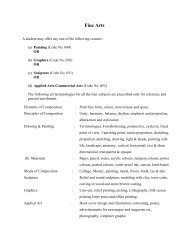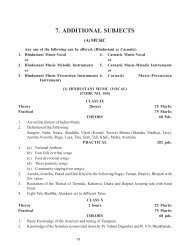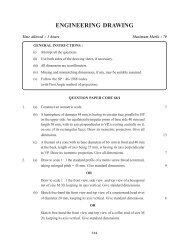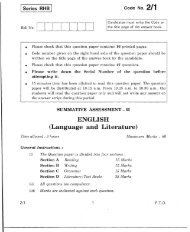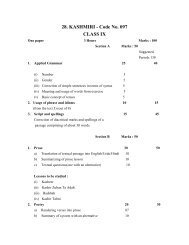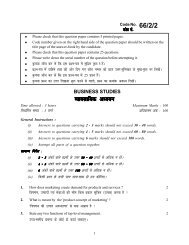A Text Book on Engineering Graphics - Central Board of Secondary ...
A Text Book on Engineering Graphics - Central Board of Secondary ...
A Text Book on Engineering Graphics - Central Board of Secondary ...
You also want an ePaper? Increase the reach of your titles
YUMPU automatically turns print PDFs into web optimized ePapers that Google loves.
ISOMETRIC PROJECTION<br />
Steps (i) Draw the helping figure <strong>of</strong> pentag<strong>on</strong> with iso 25 mm length as <strong>on</strong>e <strong>of</strong> its base edge<br />
in H.P.<br />
(ii) Draw the isometric box with OA <strong>on</strong> the horiz<strong>on</strong>tal line parallel to the directi<strong>on</strong> <strong>of</strong><br />
viewing, OB <strong>on</strong> the vertical line and OC equal to iso 55 mm <strong>on</strong> another horiz<strong>on</strong>tal<br />
line.<br />
(iii) Complete the isometric projecti<strong>on</strong> <strong>of</strong> pentag<strong>on</strong>al prism in this isometric box by the<br />
same step discussed in earlier examples.<br />
1.3.2 PYRAMIDS<br />
Example 9:<br />
Soluti<strong>on</strong> :<br />
Pyramids are the solids with a base and slant triangular faces. These faces meet at a point<br />
called apex <strong>of</strong> the pyramid. In pyramids if they are kept <strong>on</strong> their base then they are called<br />
upright / vertical pyramids but if they are kept <strong>on</strong> their vertex <strong>on</strong> H.P. then they are called<br />
inverted pyramids.<br />
Let us draw some examples.<br />
Draw the isometric projecti<strong>on</strong> <strong>of</strong> a pentag<strong>on</strong>al pyramid <strong>of</strong> base side 30 mm and axis <strong>of</strong> 60<br />
mm resting <strong>on</strong> its base <strong>on</strong> H.P. with <strong>on</strong>e <strong>of</strong> its base side parallel to V.P. and nearer to the<br />
observer.<br />
Refer Fig. 1.11<br />
Steps (i) Draw the pentag<strong>on</strong> with iso 30 mm and <strong>on</strong>e <strong>of</strong> its base edge parallel to V.P. and<br />
nearer to the observer.<br />
Example 10:<br />
(ii) Complete the helping view figure by enclosing rectangle and center lines <strong>of</strong><br />
pentag<strong>on</strong>.<br />
(iii) Copy the dimensi<strong>on</strong>s <strong>of</strong> helping figure i.e. OA and OB <strong>on</strong> the horiz<strong>on</strong>tal line as<br />
shown and draw the center lines <strong>of</strong> Pentag<strong>on</strong> in it.<br />
(iv) Draw the vertical axis in upright positi<strong>on</strong> from the center <strong>of</strong> pentag<strong>on</strong> equal to iso<br />
60 mm.<br />
(v) Join the visible edges, starting from the vertex to base corners by thick lines.<br />
(vi) Complete the isometric projecti<strong>on</strong> <strong>of</strong> pentag<strong>on</strong>al pyramid with directi<strong>on</strong> <strong>of</strong><br />
viewing and dimensi<strong>on</strong>ing.<br />
Draw the isometric projecti<strong>on</strong> <strong>of</strong> an inverted pentag<strong>on</strong>al pyramid <strong>of</strong> base side 30<br />
mm and axis <strong>of</strong> 60 mm resting <strong>on</strong> its base <strong>on</strong> H.P. with <strong>on</strong>e <strong>of</strong> its base side parallel to<br />
V.P. and nearer to the observer.<br />
ENGINEERING GRAPHICS<br />
11




